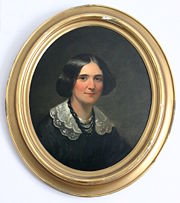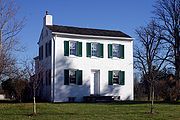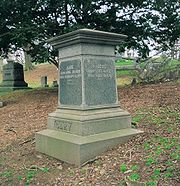
Phoebe Cary
Encyclopedia

Alice Cary
Alice Cary was an American poet, and the sister of fellow poet Phoebe Cary .-Biography:Alice Cary was born on April 26, 1820, in Mount Healthy, Ohio near Cincinnati. Her parents lived on a farm bought by Robert Cary in 1813 in what is now North College Hill, Ohio. He called the Clovernook Farm...
(1820–1871). The sisters co-published poems in 1849, and then each went on to publish volumes of her own. After their deaths in 1871, joint anthologies of the sisters' unpublished poems were also compiled.
Biography

Mount Healthy, Ohio
Mount Healthy is a city in Hamilton County, Ohio, United States, in the Cincinnati/Northern Kentucky metropolitan area. The population was 7,149 at the 2000 census.-Geography:Mount Healthy is located at ....
near Cincinnati
Cincinnati, Ohio
Cincinnati is a city in the U.S. state of Ohio. Cincinnati is the county seat of Hamilton County. Settled in 1788, the city is located to north of the Ohio River at the Ohio-Kentucky border, near Indiana. The population within city limits is 296,943 according to the 2010 census, making it Ohio's...
, and she and her sister Alice were raised on the Clovernook
Clovernook
Clovernook Farm was the family home of poets Alice and Phoebe Cary in what is now North College Hill, Ohio. The farm was once part of a 1 million acre tract of Springfield Township that was purchased in 1787 by John Cleves Symmes, a New Jersey delegate to the Continental Congress and a pioneer in...
farm in what is now North College Hill, Ohio
North College Hill, Ohio
North College Hill is a city in Hamilton County in the southwestern part of the U.S. state of Ohio approximately ten miles north of downtown Cincinnati. As of the 2010 census, the city population was 9,397...
. While she and her sister were raised in a Universalist household and held political and religious views that were liberal and reformist, they often attended Methodist, Presbyterian, and Congregationalist services and were friendly with ministers of all these denominations and others.
While they occasionally attended school, the sisters were often needed to work at home and so were largely self-educated. The sisters' mother died in 1835, and two years afterward their father married again. The stepmother was wholly unsympathetic regarding their literary aspirations. For their part, while they were ready and willing to aid to the full extent of their strength in household labor, the sisters persisted in a determination to study and write when the day's work was done. Sometimes they were refused the use of candles to the extent of their wishes, and the device of a saucer of lard with a bit of rag for a wick was their only light after the rest of the family had retired.
More outgoing than her sister, Phoebe was a champion of women's rights
Women's rights
Women's rights are entitlements and freedoms claimed for women and girls of all ages in many societies.In some places these rights are institutionalized or supported by law, local custom, and behaviour, whereas in others they may be ignored or suppressed...
and for a short time edited The Revolution, a newspaper published by Susan B. Anthony
Susan B. Anthony
Susan Brownell Anthony was a prominent American civil rights leader who played a pivotal role in the 19th century women's rights movement to introduce women's suffrage into the United States. She was co-founder of the first Women's Temperance Movement with Elizabeth Cady Stanton as President...
. In 1848, their poetry was published in the anthology Female Poets of America edited by Rufus Wilmot Griswold
Rufus Wilmot Griswold
Rufus Wilmot Griswold was an American anthologist, editor, poet, and critic. Born in Vermont, Griswold left home when he was 15 years old. He worked as a journalist, editor, and critic in Philadelphia, New York City, and elsewhere. He built up a strong literary reputation, in part due to his 1842...
and, with his help, Poems of Alice and Phoebe Cary was published in 1849. Poet John Greenleaf Whittier
John Greenleaf Whittier
John Greenleaf Whittier was an influential American Quaker poet and ardent advocate of the abolition of slavery in the United States. He is usually listed as one of the Fireside Poets...
had been invited to provide a preface but refused. He believed their poetry did not need his endorsement and also noted a general dislike for prefaces as a method to "pass off by aid of a known name, what otherwise would not pass current".

New York City
New York is the most populous city in the United States and the center of the New York Metropolitan Area, one of the most populous metropolitan areas in the world. New York exerts a significant impact upon global commerce, finance, media, art, fashion, research, technology, education, and...
. There, they often hosted evening receptions on Sundays, some of which were attended by well-known figures such as P. T. Barnum
P. T. Barnum
Phineas Taylor Barnum was an American showman, businessman, scam artist and entertainer, remembered for promoting celebrated hoaxes and for founding the circus that became the Ringling Bros. and Barnum & Bailey Circus....
, John Greenleaf Whittier, and Elizabeth Cady Stanton
Elizabeth Cady Stanton
Elizabeth Cady Stanton was an American social activist, abolitionist, and leading figure of the early woman's movement...
. While in New York, Phoebe published two volumes of exclusively her own poetry: Poems and Parodies and Poems of Faith, Hope, and Love. Additionally, her lyrics appeared in many church hymnals, on Sunday School cards, and in household scrapbooks. One of her hymns, "Nearer Home," was often sung at funerals, including Alice's and her own.
In the joint housekeeping in New York, Phoebe took, from choice (Alice being for many years an invalid), the larger share of the household duties, and hence found less leisure for literary labor. She wrote very little prose, and her poetry was so different in style, so much more buoyant in tone and independent in manner, that the verses of one sister were rarely ascribed to the other.
Alice died in 1871 from tuberculosis
Tuberculosis
Tuberculosis, MTB, or TB is a common, and in many cases lethal, infectious disease caused by various strains of mycobacteria, usually Mycobacterium tuberculosis. Tuberculosis usually attacks the lungs but can also affect other parts of the body...
; Phoebe died five months later of hepatitis
Hepatitis
Hepatitis is a medical condition defined by the inflammation of the liver and characterized by the presence of inflammatory cells in the tissue of the organ. The name is from the Greek hepar , the root being hepat- , meaning liver, and suffix -itis, meaning "inflammation"...
on July 31, 1871, in Newport, Rhode Island
Newport, Rhode Island
Newport is a city on Aquidneck Island in Newport County, Rhode Island, United States, about south of Providence. Known as a New England summer resort and for the famous Newport Mansions, it is the home of Salve Regina University and Naval Station Newport which houses the United States Naval War...
. Both were buried in Green-Wood Cemetery
Green-Wood Cemetery
Green-Wood Cemetery was founded in 1838 as a rural cemetery in Brooklyn, Kings County , New York. It was granted National Historic Landmark status in 2006 by the U.S. Department of the Interior.-History:...
, Brooklyn, New York.
Works
- Poems of Alice and Phoebe Cary (1849)
- Poems and Parodies (Ticknor, Reed & Fields, Boston 1854)
- Poems of Faith, Hope, and Love (1867)
- A Memorial of Alice and Phoebe Cary With Some of Their Later Poems, compiled and edited by Mary Clemmer Ames (1873)
- The Last Poems of Alice and Phoebe Cary, compiled and edited by Mary Clemmer Ames (1873)
- Ballads for Little Folk by Alice and Phoebe Cary, compiled and edited by Mary Clemmer Ames (1873)
As editor and compiler:
- Hymns for all Christians (1869, compiled by Charles Force Deems and Phoebe Cary)
Note: In early volumes, "Cary" was spelled "Carey" in and on Phoebe and Alice Cary's books, and later editions and volumes changed the spelling to "Cary."

